Bayesian probability is an interpretation of the concept of probability, in which, instead of frequency or propensity of some phenomenon, probability is interpreted as reasonable expectation representing a state of knowledge or as quantification of a personal belief.
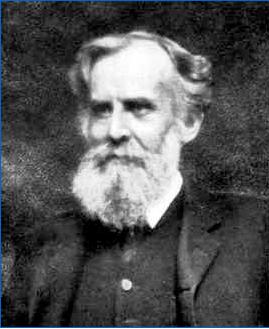
Frequentist probability or frequentism is an interpretation of probability; it defines an event's probability as the limit of its relative frequency in many trials. Probabilities can be found by a repeatable objective process. The continued use of frequentist methods in scientific inference, however, has been called into question.

Probability is the branch of mathematics concerning numerical descriptions of how likely an event is to occur, or how likely it is that a proposition is true. The probability of an event is a number between 0 and 1, where, roughly speaking, 0 indicates impossibility of the event and 1 indicates certainty. The higher the probability of an event, the more likely it is that the event will occur. A simple example is the tossing of a fair (unbiased) coin. Since the coin is fair, the two outcomes are both equally probable; the probability of "heads" equals the probability of "tails"; and since no other outcomes are possible, the probability of either "heads" or "tails" is 1/2.
The word probability has been used in a variety of ways since it was first applied to the mathematical study of games of chance. Does probability measure the real, physical, tendency of something to occur, or is it a measure of how strongly one believes it will occur, or does it draw on both these elements? In answering such questions, mathematicians interpret the probability values of probability theory.
In probability theory and statistics, Bayes' theorem, named after Thomas Bayes, describes the probability of an event, based on prior knowledge of conditions that might be related to the event. For example, if the risk of developing health problems is known to increase with age, Bayes' theorem allows the risk to an individual of a known age to be assessed more accurately by conditioning it relative to their age, rather than simply assuming that the individual is typical of the population as a whole.
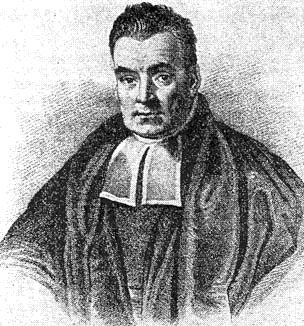
Thomas Bayes was an English statistician, philosopher and Presbyterian minister who is known for formulating a specific case of the theorem that bears his name: Bayes' theorem. Bayes never published what would become his most famous accomplishment; his notes were edited and published posthumously by Richard Price.
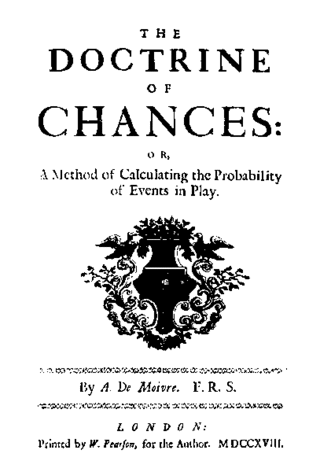
The Doctrine of Chances was the first textbook on probability theory, written by 18th-century French mathematician Abraham de Moivre and first published in 1718. De Moivre wrote in English because he resided in England at the time, having fled France to escape the persecution of Huguenots. The book's title came to be synonymous with probability theory, and accordingly the phrase was used in Thomas Bayes' famous posthumous paper An Essay towards solving a Problem in the Doctrine of Chances, wherein a version of Bayes' theorem was first introduced.
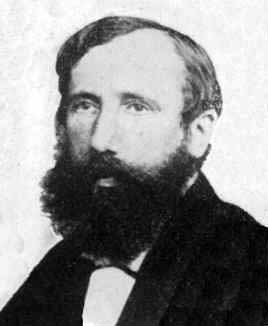
Isaac Todhunter FRS, was an English mathematician who is best known today for the books he wrote on mathematics and its history.

Pierre-Simon, marquis de Laplace was a French scholar and polymath whose work was important to the development of engineering, mathematics, statistics, physics, astronomy, and philosophy. He summarized and extended the work of his predecessors in his five-volume Mécanique céleste (1799–1825). This work translated the geometric study of classical mechanics to one based on calculus, opening up a broader range of problems. In statistics, the Bayesian interpretation of probability was developed mainly by Laplace.

In the history of science, Laplace's demon was a notable published articulation of causal determinism on a scientific basis by Pierre-Simon Laplace in 1814. According to determinism, if someone knows the precise location and momentum of every atom in the universe, their past and future values for any given time are entailed; they can be calculated from the laws of classical mechanics.
The year 1814 in science and technology involved some significant events, listed below.
The classical definition or interpretation of probability is identified with the works of Jacob Bernoulli and Pierre-Simon Laplace. As stated in Laplace's Théorie analytique des probabilités,
Statistics, in the modern sense of the word, began evolving in the 18th century in response to the novel needs of industrializing sovereign states.

Irénée-Jules Bienaymé was a French statistician. He built on the legacy of Laplace generalizing his least squares method. He contributed to the fields of probability and statistics, and to their application to finance, demography and social sciences. In particular, he formulated the Bienaymé–Chebyshev inequality concerning the law of large numbers and the Bienaymé formula for the variance of a sum of uncorrelated random variables.
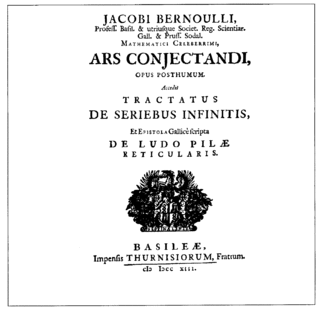
Ars Conjectandi is a book on combinatorics and mathematical probability written by Jacob Bernoulli and published in 1713, eight years after his death, by his nephew, Niklaus Bernoulli. The seminal work consolidated, apart from many combinatorial topics, many central ideas in probability theory, such as the very first version of the law of large numbers: indeed, it is widely regarded as the founding work of that subject. It also addressed problems that today are classified in the twelvefold way and added to the subjects; consequently, it has been dubbed an important historical landmark in not only probability but all combinatorics by a plethora of mathematical historians. The importance of this early work had a large impact on both contemporary and later mathematicians; for example, Abraham de Moivre.
The following is a timeline of probability and statistics.
Probability has a dual aspect: on the one hand the likelihood of hypotheses given the evidence for them, and on the other hand the behavior of stochastic processes such as the throwing of dice or coins. The study of the former is historically older in, for example, the law of evidence, while the mathematical treatment of dice began with the work of Cardano, Pascal, Fermat and Christiaan Huygens between the 16th and 17th century.
An Essay towards solving a Problem in the Doctrine of Chances is a work on the mathematical theory of probability by Thomas Bayes, published in 1763, two years after its author's death, and containing multiple amendments and additions due to his friend Richard Price. The title comes from the contemporary use of the phrase "doctrine of chances" to mean the theory of probability, which had been introduced via the title of a book by Abraham de Moivre. Contemporary reprints of the Essay carry a more specific and significant title: A Method of Calculating the Exact Probability of All Conclusions founded on Induction.

LaplacesDemon is an open-source statistical package that is intended to provide a complete environment for Bayesian inference. LaplacesDemon has been used in numerous fields. The user writes their own model specification function and selects a numerical approximation algorithm to update their Bayesian model. Some numerical approximation families of algorithms include Laplace's method, numerical integration, Markov chain Monte Carlo (MCMC), and variational Bayesian methods.









